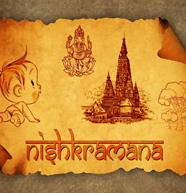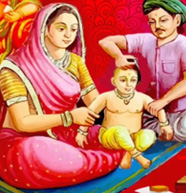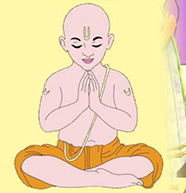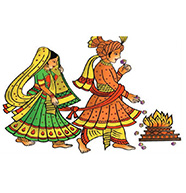16 Sanskar of Sanatan Dharma
Sanskar provides a spiritual touch at different stages of a sanatan life from achieving spiritual nourishment, peace of mind to ultimately moksha. The word Sanskar was defined by Maharishi Veda Vyas who states that the sanskars have many qualities within themselves
Sanatan Dharma refers to the set of different religions and beliefs followed since ancient times. All these rules which are framed for the life of a person in this religion, have scientific basis also. Life is divided into four ashrams. It is mandatory for a person to observe 16 types of Sanskars when they live in these ashramas
Inculcation of positive thoughts, Correcting, rectifying, sanctifying yourself, promotion, etiquettes, decency, customs, religious acts, etc. are all part of the sacrament. Sanskar is the consciousness of any religion that teaches those of that religion to live. Rituals are the hallmarks of our religious and social life.
However, the number of rituals in different scriptures are also different. Sixteen sanskars have been made by sanatanis from the birth of a person to death, which purifies his/her spiritual journey.
So let’s know these 16 sanskars of the oldest Sanatan Dharma and their importance.

GARBHADHAN (CONCEPTION )
This is the first sanskar of human life. It is the prayer done to receive qualified, virtuous and ideal offspring. Parents who wish for the best progeny should perform these rites for the purity of their body and mind for conception. It has been said, “Janmna, Jayate Shudra-Sanskrit Dwij which means all are shudras from birth and the person is made dwija by sanskars. Under this, a woman and a man should measure their health and mental state before childbirth.

PUMSAVANA (FETUS PROTECTION )
The second rites takes care to ensure that the future mother’s diet, conduct, behaviour, thinking, emotions are all made better and balanced when they are pregnant.This sanskar ceremony is performed within 3 to 4 months of pregnancy and is to be performed when someone desires a male child. Like the first Sanskar i.e. Garbhadhan, Punsavana Sanskar is also restricted to the family members.
It is said that the pregnant woman should condone the sacred texts like the Gita and the Ramayana every day, consume a good diet, stay in a positive atmosphere, take family blessings etc . This develops the baby’s thinking system.

SIMANTONNAYANA (SATISFYING WISHES OF THE PREGNANT MOTHER)
This third rite is the only extension of punsavan and is performed during the seventh month of pregnancy for the healthy physical and mental growth of the child. Simantonnayan sanskar means “simant” i.e. ‘hair and upgrade’ i.e. ‘raising’. Under these rites, the husband raises his wife’s hair upwards, so the name of the rite becomes ‘Simantonnayan’.
A Puja is performed as an offering to God for the peace of mother and infant, for giving birth to a peaceful and holy child. This is a type of purification process of the womb.

JATAKARMA (BIRTH RITUALS )
Jaat-karma birth ritual is performed on six days from the child birth for the purification of the house. This is done to keep a child in a clean atmosphere to avoid any physical or mental problems. The process is also called Shashthi. Goddess Shashthi is the protector of children. Jaat-karma is followed by Grih Puja, Homa.

NAMKARAN (NAME – GIVING)
This Sanskar is performed on the tenth day of birth with recitation of Mantras providing the name to the baby child according to the 27 Nakshatra and the position of the moon at the time of child’s birth. The first letter of the name is taken from the Hora Shatra.

NISHKRAMANA (Evacuation)
This ceremony is performed in the fourth month when the child is brought into the external environment for the first time. For the first time, under the sacrament, the newborn child is given the light of the sun and the moon. It is believed that if the cold morning sun and the cool shadow of the moon fall on the newborn in the evening, it is protected from serious diseases like jaundice, typhoid.
This Sanskar is said to show obedience to the five elements - the Panchmahabhut : sun, moon, fire, wind, water etc. to enhance the age and physical and mental development of the child.

ANNAPRASHANA (GIVING THE CHILD SOLID FOOD)
This sanskar is performed in the sixth month in which solid food (anna) is served to the baby in a silver bowl or plate for the first time. It is especially fed with kheer when hot milk is added to the silver bowl, it contains the nutrients of silver which are necessary to strengthen the body. Mantras are recited and oblations are offered to the various deities. The baby is able to grow only by lactating the mother.

CHUDAKARANA OR MUNDAN (HAIR CUTTING)
This Sanskar is performed on an auspicious day after the age of one year when the child's hair is cut for the first time. The hair is disposed of at holy places. The ceremony is performed for the development of power, better understanding, and for long life. Mundan sanskar leads to the elimination of many defects. This rite happens with the whole mantra in which Muhurat and Nakshatra Dasha have special significance..

KARNAVEDHA (EAR PIERCING )
This sanskar is performed in the third or fifth year, when the child's ears are pierced in the auspicious Muhurat of Shukla Paksha. With the commencement of Surya Puja the right ear of the child is first addressed by the father so that the child may listen to good things and have a good education. According to religious facts, ear-piercing removes diseases and the hearing power also increases.

UPANAYANA OR YAGYOPAVEET (WEARING OF THE SACRED THREAD)
Upanayana is the ceremony of wearing the sacred thread called Yagnopaveetham. When male child attains 5 years, then he is made to wear the sacred thread above the left shoulder and under the right arm. Along with the sacred thread, the hide of the antelope called Krishnajina is also worn by the boy. The Upanayana ceremony is followed by brahmopadesham – teaching Gayatri mantra to the boy.
This Sanskar is the second birth for a child – A spiritual birth where he is dressed with janeu. The child is thereafter authorized to perform all rituals.
The ceremony has six parts: –
Puja: Worshipping the Gods
Havan: Sacrifice
Shiksha: Teaching the morality and duties in life
Bhiksha: Begging as a renounced Brahmchari of Gurukula. Teacher’s teaching has made him renounced minded that he has accepted a life of Vairagee
Diksha: Giving the most sacred Gayatri Mantra to the child
Blessings: Child is bless by all Gods, Goddesses, ancestors and elders
After the process the child is taken to Guru for initiation of formal education.

VIDYARAMBH (STUDY OF VEDAS AND SCRIPTURES )
This Sanskar is performed along with Upanayana where a child commences his journey on the road to spiritual life. Vedarambha is the learning of Vedas and Upanishads in ‘Gurukula’ or ‘Pathashala’. With the start of the academic period a ceremony called Upakarma is performed and at the end of each academic period Upah Sarjana ceremony is performed. The child is sent to Gurukul for the child to start his studies.

SAMAVARTANA (COMPLETING THE EDUCATION)
Samavartan ceremony is performed when the formal education of Vedas in ‘Gurukul’ is completed. After learning the rules of life, religion and culture, the child returns home from gurukul. His first Ashram Brahmacharya is complete making him eligible to enter into the householder stage and is considered a qualified man ready to get married.

VIVAHA (THE MARRIAGE)
This sanskar makes him ready for the second Ashram where his life as an individual family begins. Vedic Hindu marriage which is a strong bond between a man and a woman takes place in the presence of their parents, relatives and friends. The bride and groom walk around Agni hand in hand and the bride sacrifices grains in the fire followed by chanting of the mantras.

VANPRASTHA (PREPARING FOR RENOUNCING)
This ceremony is performed between the ages of 50-60 years when a man completes his Grahastha Dharma and enters into Vanprastha Ashram i.e. forest hermit. He has to withdraw all worldly activities, get retired into the forest and prepare himself for taking sanyas living the life of a Vanprastha.

SANYASA
This ceremony makes a Hindu shed all sense of responsibility & relationships before leaving the body. A sanyasi renounces the world and leads a life of study and meditation by living on alms.

ANTYESHTI ( LAST RITE )
Antyeshti, the last rites referred to as Antim-Sanskar, is performed at the time of funeral. When death occurs, a small piece of gold, tulsi leaf and gangajal are put in the mouth of the dead person. The body is laid on the ground with the head towards the north and is washed, perfumed and wrapped in a new white cloth and decked with flowers. The eldest son generally performs the last rites before which he takes a purificatory bath followed by the chanting of mantras. For ten days after the death, food is not prepared at home and is brought from the house of relatives and friends.
